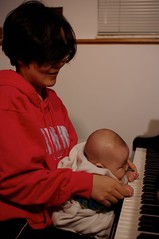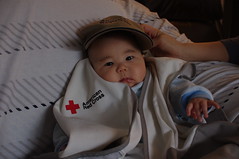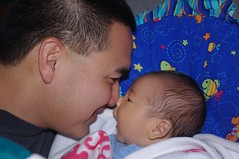I got the Maya Wrap soon after my son was born. While we had a Baby Bjorn, I was looking for something not so bulky, and something with some more flexibility in how it is used.
The Maya Wrap is an example of a Ring Sling, which is an example of a fabric carrier. Essentially, it is a long piece of cloth threaded through 2 rings similar to D-rings used with webbing for camping equipment. The baby sits in the pouch, and the cloth is adjusted by sliding it through the D-ring. By adjusting the parts of the cloth (either end or the middle) you can set the tension across the baby's entire body. The Maya Wrap is made up of a breathable cotton and is rated for newborn through 35 lbs. There are ring slings marketed that are made of patterned fabrics, or in silk (for special occasions) In principle, a baby can be held in a cradle hold (pictured) upright tummy-to-tummy, kangaroo hold (facing forward) or hip straddle. Initially I used cradle holds, but I've switched to upright (more on why later).
Given that it is missing the precisely located straps and buckles, one question is how do you know it is being used correctly. There are a few guidelines that are true for all baby carriers (and some carriers fail these)
1. Baby is seated in the carrier. If you think about how you hold a baby for extended periods of time, most carries involve support across the baby's bum and across the back. So a carrier should do the same. The main way many carriers fail is to hold the baby in between the legs at the crotch vice across the entire bum. In particular, the fabric should be supporting part of the thigh and the knees should be higher then the butt.
2. Baby's back is supported. A baby's back is naturally bent into a C, but the carrier should not exaggerate the C. A class of carrier called bag slings were notable for this (think of a pouch, and the baby sitting in the bottom of the pouch). And Bag slings were recently banned by the Consumer Products Safety Commission. The test for this is to look at the baby's chin. The baby's head does not follow the C of the spine, so the chin should not be against the baby's chest. (and if you can't see it, you probably have the baby positioned too low)
Things I like about the Maya wrap.
1. Once we got past the initial learning curve (first three time trying it) it was easy to drop T into the sling.
2. It is very compact. It does not take up much room in a bag.
3. Few moving parts. It was easy to set up and have it ready. Now straps or buckles all over the place.
4. My son has been diagnosed as colicy. And putting him in the sling upright has been a sure way of calming him down. (or even letting him sleep in there.)
5. My two month old son is also easily scared. Between the sling pouch and the tail, we can basically hide him, and cut down on the sensory overload that is the world around him.
6. Wearing the sling, I can eat while holding him. Basically, my hands are relatively free (although I usually have a hand on his back or bottom when I have the sling on)
7. For that matter, I can do some other things wearing the sling that need my hands. Listening to music on my ipod. Reading books or my ereader. Packing/unpacking
Things not so nice.
1. There is a learning curve. My wife and both of our parents don't want to use it because they don't like how it works. And things have to be adjusted reasonably well to sit on your shoulder and have the baby in a comfortable position. Once you get the hang of it, it is not hard, but you need to put some work in to get there.
2. It is a pouch, so there is not much ventilation inside the baby compartment. The cotton fabric is breathable, but the baby will be warm because it is essentially another layer of clothing (in addition to the body heat)
Over all, I love it and I'm glad I got it. T does not like the Bjorn so much and because he is colicy, having the ring sling makes it conceivable to go out even though we have to hold him constantly.
Maya wrap is available direct from
Maya Wrap. There are also a number of sellers listed on Amazon.com. Retail availability seems limited, but apparently there are a number of home-based businesses that cater to baby and children needs that also sell babywearing products, including ring slings.
 This month has been a battle with colic in its various forms. And we have been working through reflux, thrush, eczema, allergies, and the myriad other causes and cures that multiple cultures have come up with for colic. And more to come, recognizing every culture on earth probably has more candidate cures then the standard length of colic. So we have about another month of this to go. While my wife and I are both marathoners who have proven endurance and ability to endure pain and suffering, the in-laws who are with us and take care of T when we are working are not. And my wife and I are considerably better at calming T down when he is wailing away then they are. A case where the skills are mismatched to the need.
This month has been a battle with colic in its various forms. And we have been working through reflux, thrush, eczema, allergies, and the myriad other causes and cures that multiple cultures have come up with for colic. And more to come, recognizing every culture on earth probably has more candidate cures then the standard length of colic. So we have about another month of this to go. While my wife and I are both marathoners who have proven endurance and ability to endure pain and suffering, the in-laws who are with us and take care of T when we are working are not. And my wife and I are considerably better at calming T down when he is wailing away then they are. A case where the skills are mismatched to the need. The big controversy in parenting around now is Amy Chua's book "Battle Hymn of the Tiger Mother" that just came out. Chua writes as an advocate for "chinese parenting", meaning being strict with the children, letting them you know you believe they can achieve, and not letting them settle for less then their potential. There is a lot of commentary on the book, from those who are agast at it and those who defend the way described as the way to do it.
The big controversy in parenting around now is Amy Chua's book "Battle Hymn of the Tiger Mother" that just came out. Chua writes as an advocate for "chinese parenting", meaning being strict with the children, letting them you know you believe they can achieve, and not letting them settle for less then their potential. There is a lot of commentary on the book, from those who are agast at it and those who defend the way described as the way to do it. That said, there are things that we want. We want our son to know that we believe him to be capable of being great. We want him to realize that this is not because of giftedness or being a prodigy, but because of hard work and grit. That we expect him to be capable of things that are hard, and thing that are hard are worth the effort needed to accomplish them. And that it is worth respecting and emulating competence and wisdom where it can be found. These are not widespread beliefs. And it is hardly guaranteed that he will
That said, there are things that we want. We want our son to know that we believe him to be capable of being great. We want him to realize that this is not because of giftedness or being a prodigy, but because of hard work and grit. That we expect him to be capable of things that are hard, and thing that are hard are worth the effort needed to accomplish them. And that it is worth respecting and emulating competence and wisdom where it can be found. These are not widespread beliefs. And it is hardly guaranteed that he will












